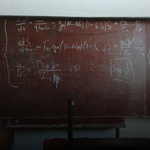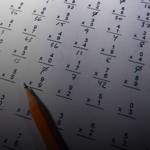Section 1
Preview this deck
ln 1
Front
Active users
0
All-time users
0
Favorites
0
Last updated
4 years ago
Date created
Mar 1, 2020
Cards (123)
Section 1
(50 cards)
ln 1
0
Volume of a Sphere
V = 4/3 pi r^3
ln (mn)
ln m + ln n
cos π/4
√2/2
cos π/2
0
Volume of a cone
πr²h/3
1 + cot²x
csc²x
sin π/4
√2/2
Continuity & differentiability
Differentiability implies continuity, but continuity does not necessarily imply differentiability.
Surface Area of a Sphere
S = 4 pi r^2
Circumference of a circle
2πr
sin π/6
1/2
sin(2x)
2 sin x cos x
sin π/3
√3/2
cos π/6
√3/2
sin 0
0
cos 3π/2
0
1 + tan²x
sec²x
Continuity on a closed interval, [a,b]
1. f(x) is continuous on the closed interval (a,b) 2. The limit from the right as x approaches a of f(x) is f(a) 3. The limit from the left as x approaches b of f(x) is f(b)
The limit as x approaches 0 of sin x / x
1
sin π/2
1
Limit Definition of a Derivative
f'(x) = lim as ∆x → 0 of [ f(x + ∆x) - f(x) ] / ∆x
Continuity at a point (x = c)
1. f(x) is defined at f(c) 2. The limit as x approaches c of f(x) exists 3. The limit as x approaches c of f(x) = f(c)
If f(-x) = f(x)
f is an even function
ln (m/n)
ln m - ln n
Area of an equilateral triangle
√3s² / 4
If f(-x) = -f(x)
f is an odd function
Continuity on an open interval, (a,b)
f(x) is continuous if for every point on the interval (a,b) the conditions for continuity at a point are satisfied.
The limit as x approaches 0 of (1 - cos x) / x
0
csc x
1 / sin x
cos(2x)
cos²x - sin²x
cos π/3
1/2
ln e
1
tan x
sin x / cos x
sin²x
(1 - cos 2x) / 2
sec x
1 / cos x
sin 3π/2
-1
How to get from precalculus to calculus
Limits
Alternate Limit Definition of a derivative
f'(x) = lim as x → c of [ f(x) - f(c) ] / [ x - c]
Area of a circle
πr²
Volume of a right circular cylinder
πr²h
cos π
-1
Indeterminate form
0/0
cos 0
1
cot x
1 / tan x = cos x / sin x
cos²x + sin²x
1
cos²x
(1 + cos 2x) / 2
Intermediate Value Theorem
If f(x) is continuous on a closed interval [a,b] and k is any number between f(a) and f(b), then there is at least one number c in [a,b] such that f(c) = k.
sin π
0
ln mⁿ
n ln m
Section 2
(50 cards)
d/dx[log_a u]
u'/((ln a) u)
d/dx[cot x]
-csc² x
Instantaneous velocity
Derivative of position at a point
∫k f(x) dx
k ∫ f(x) dx
d/dx[arccsc x]
-1/(|x|√(x²-1))
d/dx[sec x]
sec x tan x
Mean Value Theorem
if f(x) is continuous and differentiable, slope of tangent line equals slope of secant line at least once in the interval (a, b) f '(c) = [f(b) - f(a)]/(b - a)
d/dx[arccot x]
-1/(1+x²)
d/dx[x]
1
d/dx[arcsin x]
1/√(1-x²)
d/dx[csc x]
-csc x cot x
The Product Rule
If two functions, f and g, are differentiable, then d/dx[ f(x) g(x) ] = f(x) g'(x) + g(x) f'(x)
Guidelines for implicit differentiation
1. Differentiate both sides w.r.t. x 2. Move all y' terms to one side & other terms to the other 3. Factor out y' 4. Divide to solve for y'
Derivative of an inverse (if g(x) is the inverse of f(x))
g'(x) = 1/f'(g(x)), f'(g(x)) cannot = 0
d/dx[arctan x]
1/(1+x²)
d/dx[log_a x]
1/((ln a) x)
∫cos x dx
sin x + C
Position function of a falling object (with acceleration in m/s²)
s(t) = -4.9t²+ v₀t + s₀, v₀ = initial velocity, s₀ = initial height
d/dx[ln u]
u'/u, u > 0
d/dx[ f(x) g(x) ]
f(x) g'(x) + g(x) f'(x)
Average speed
∆s/∆t
d/dx[sin x]
cos x
d/dx[e^u]
u' e^u
∫sin x dx
-cos x + C
Derivative of a constant
d/dx[c] = 0
Derivative
Slope of a function at a point/slope of the tangent line to a function at a point
d/dx[arcsec x]
1/(|x|√(x²-1))
Rolle's Theorem
Let f be continuous on [a,b] and differentiable on (a,b) and if f(a)=f(b) then there is at least one number c on (a,b) such that f'(c)=0 (If the slope of the secant is 0, the derivative must = 0 somewhere in the interval).
Extreme Value Theorem
If f is continuous on the closed interval [a,b] then it must have both a minimum and maximum on [a,b].
Sum and Difference Rules for Derivatives
d/dx[f(x) ± g(x)] = f'(x) ± g'(x)
d/dx[cos x]
-sin x
∫0 dx
C
FUNdamental Theorem of Calculus
∫ f(x) dx on interval a to b = F(b) - F(a)
d/dx[ln x]
1/x, x>0
Chain Rule: d/dx[f(g(x))] =
f'(g(x))g'(x)
Constant Multiple Rule for Derivatives
d/dx[cf(x)] = c f'(x)
d/dx[ f(x) / g(x) ]
[g(x)f'(x) - f(x) g'(x)] / [g(x)]²
Position function of a falling object (with acceleration in ft/s²)
s(t) = -16t²+ v₀t + s₀, v₀ = initial velocity, s₀ = initial height
∫k dx
kx + C
d/dx[tan x]
sec² x
Velocity, v(t)
Derivative of Position, s'(t)
d/dx[a^u]
u' (ln a) a^u
∫xⁿ dx
xⁿ⁺¹ / (n + 1) + C
Power Rule for Derivatives
d/dx[x^n]=nx^(n-1)
d/dx[arccos x]
-1/√(1-x²)
Critical number
x values where f'(x) is zero or undefined.
d/dx[a^x]
(ln a) a^x
d/dx[e^x]
e^x
The Quotient Rule
If two functions, f and g, are differentiable, then d/dx[ f(x) / g(x) ] = [g(x)f'(x) - f(x) g'(x)] / [g(x)]²
Guidelines for solving related rates problems
1. Given, Want, Sketch 2. Write an equation using variables given/to be determined 3. Differentiate w.r.t. time (using chain rule) 4. Plug in & solve
Section 3
(23 cards)




